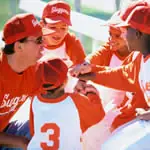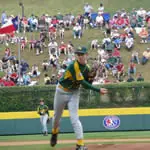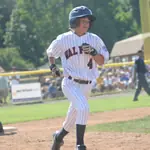There are three types of slides in baseball:
The Pop-up Slide
A base runner will end up in a standing position after the pop-up slide, allowing him to use his momentum to continue running in the event of an error or overthrow.
The player starts his slide closer to the base and rather than leaning back, will keep his torso in an upright position. This lowers the base runner's center of gravity.
The runner will brace his straight leg against the base and this, along with his torso positioning, will allow him to pop up to a standing position.
More: Which Sports Camp Is Right For You?
The Hook Slide
The hook slide is very effective when a player is trying to avoid being tagged. A player can slide into either side of the base depending on which direction the tag is coming from. When executing a hook slide, a player's position is modified so that he is sliding on the side of his body, on the leg and calf nearest the base. As he slides into the side of the bag he will reach back for the base with his hand.The Head-First Slide
The head-first slide is beneficial because it keeps a player going in the same direction without losing momentum due to shifting into a feet-first slide. As the player is running toward the base he should lower his center of gravity and extend his body forward. It's important to keep the elbows slightly bent, and keep the hands and forearms outstretched toward the bag. Touch the base with the wrists cocked backward and fingers curled up to avoid jammed fingers.Check the Rules: Note that some youth baseball leagues do not allow the head-first slide. Make sure to review the rules for your team or league.
More: 4 Biggest Mistakes Baseball Teams Make in Practice
When to Slide
More experienced players will know when they should slide to avoid being tagged or break up a double play, but there are also ways for coaches to communicate to their players that they should slide.
"Our team uses a loud 'Get Down,' which is accompanied by the coach pushing the palms of both hands rapidly down towards the ground," Miljas says. "Players are also instructed to slide whenever they see an opposing player try to tag them or set up for a tag, or when they are approaching a base too quickly. This helps them stop before their momentum takes them off the base."
The third base coach can use hand signals and verbal cues to help a player running to second base, since the throw can often be coming from behind the runner.
Coaches should help their young players learn to slide safely, and develop a system to communicate the best time to slide in game situations.
- 2
- of
- 2
About the Author

 Find
Find 




Discuss This Article